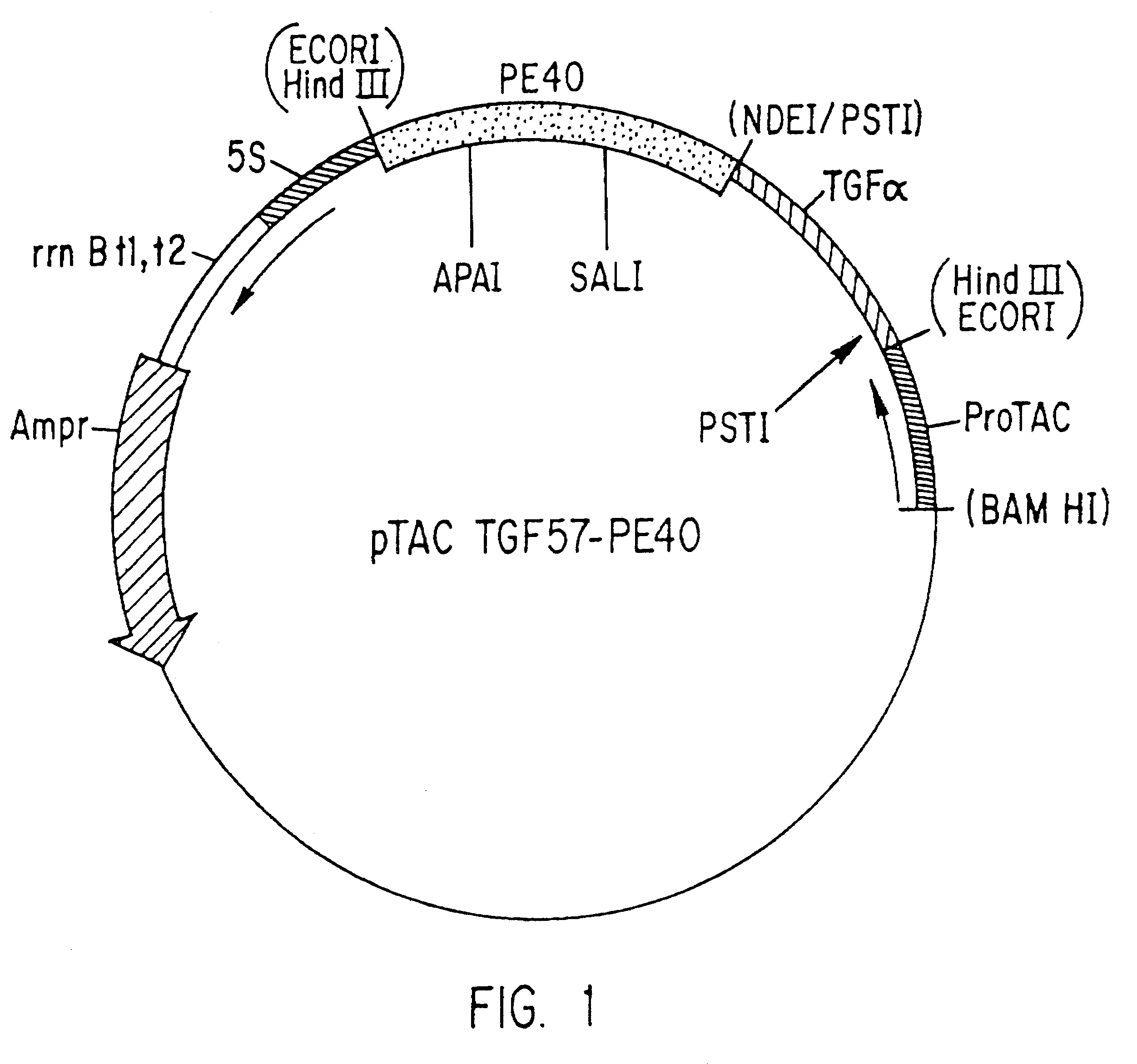Modified PE40 toxin fusion proteins
a technology of toxin fusion and pe40, which is applied in the field of modified pe40 toxin fusion proteins, can solve the problems of frequent killing of normal cells as well as tumor cells, and toxicity to normal cells, and achieves the effect of rapid purification
- Summary
- Abstract
- Description
- Claims
- Application Information
AI Technical Summary
Benefits of technology
Problems solved by technology
Method used
Image
Examples
example 2
Construction of Recombinant DNA Clones Containing TGF-alpha-PE.sub.4 DNA
The TGF-alpha DNA segment was constructed using three sets of synthetic oligonucleotides as described by Defeo-Jones et al., Molecular and Cellular Biology 8: 2999-3007 1988. This synthetic TGF-alpha gene was cloned into pUC-19. DNA from the pUC-19 clone containing recombinant human TGF-alpha was digested with Sph I and Eco RI. The digestion generated a 2.8 kb DNA fragment containing all of pUC-19 and the 5' portion of TGF-alpha. The 2.8 kb fragment was purified and isolated by gel electrophoresis. An Eco RI to Sph I oligonucleotide cassette was synthesized. This synthetic cassette had the sequence indicated below:
5'-CGGACCTCCTGGCTGCGCATCTAGG-3'3'-GTACGCCTGGAGGACCGACGCGTAGATCCTTAA-5'
For convenience, this oligonucleotide cassette was named 57. Cassette 57 was annealed and ligated to the TGF-alpha containing 2.8 kb fragment forming a circularized plasmid. Clones which contained the cassette were identified by hybr...
example 3
Construction of Modified Versions of Recombinant TGF-alpha-PE.sub.40 Containing DNA Clones: Substitution of Alanin for Cysteines
TGF-alpha-PE.sub.40 aB:
The clone pTAC TGF57-PE40 was digested with SphI and BamHI and the 750 bp SphI-BamHI fragment (specifying the C-terminal 5 amino acids of TGF-alpha and the N-terminal 243 amino acids of PE.sub.40) was isolated. M13 mp19 vector DNA was cut with SphI and BamHI and the vector DNA was isolated. The 750 bp SphI-BamHI TGF-alpha-PE.sub.40 fragment was ligated into the M13 vector DNA overnight at 15.degree. C. Bacterial host cells were transformed with this ligation mixture, candidate clones were isolated and their plasmid DNA was sequenced to insure that these clones contained the proper recombinant DNAs. Single stranded DNA was prepared for mutagenesis.
An oligonucleotide (oligo #132) was synthesized and used in site directed mutagenesis to introduce a HpaI site into the TGF-alpha-PE.sub.40 DNA at amino acid position 272 of PE.sub.40 :
5' CTG...
example 4
Construction of Modified Versions of Recombinant TGF-alpha-PE.sub.40 Containing DNA Clones: Selection of Cysteine Residues
TGF-alpha-PE.sub.40 aB, TGF-alpha-PE.sub.40 Ab, and TGF-alpha-PE.sub.40 ab can also be constructed by removing the cysteine residues at locus "A" and / or locus "B". Construction of these versions of TGF-alpha-PE.sub.40 are accomplished identically as described in Example 3 except that: for TGF-alpah-PE.sub.40 aB oligonucleotide cassette 153 is changed such that the alanine codon intended for position 265 is deleted and oligonucleotide cassette 142 is changed such that the alanine codon intended for position 287 is deleted. For TGF-alpha-PE.sub.40 Ab oligonucleotide cassette 155 is changed such that the alanine codons intended for residues 372 and 379 are deleted. For TGF-alpha-PE.sub.40 ab the DNA fragments used to construct this recombinant gene are taken from the TGF-alpha-PE.sub.40 aB and TGF-alpha-PE.sub.40 Ab gene described in this example.
PUM
 Login to View More
Login to View More Abstract
Description
Claims
Application Information
 Login to View More
Login to View More - R&D
- Intellectual Property
- Life Sciences
- Materials
- Tech Scout
- Unparalleled Data Quality
- Higher Quality Content
- 60% Fewer Hallucinations
Browse by: Latest US Patents, China's latest patents, Technical Efficacy Thesaurus, Application Domain, Technology Topic, Popular Technical Reports.
© 2025 PatSnap. All rights reserved.Legal|Privacy policy|Modern Slavery Act Transparency Statement|Sitemap|About US| Contact US: help@patsnap.com

